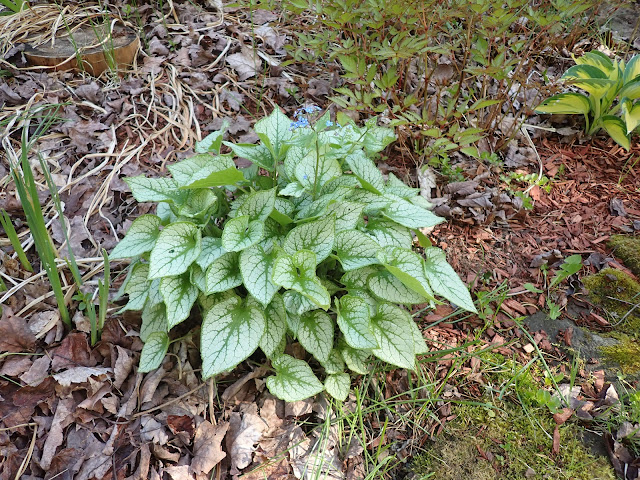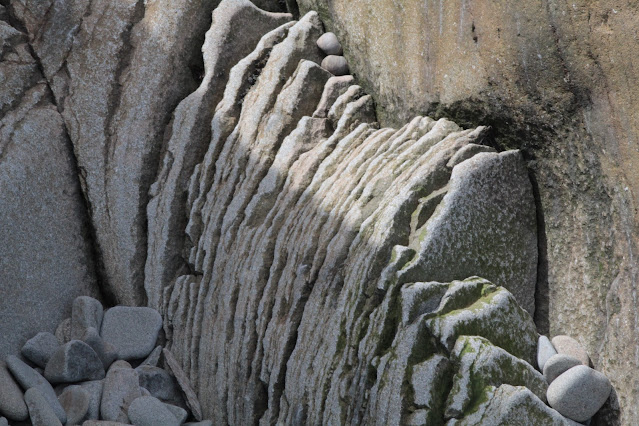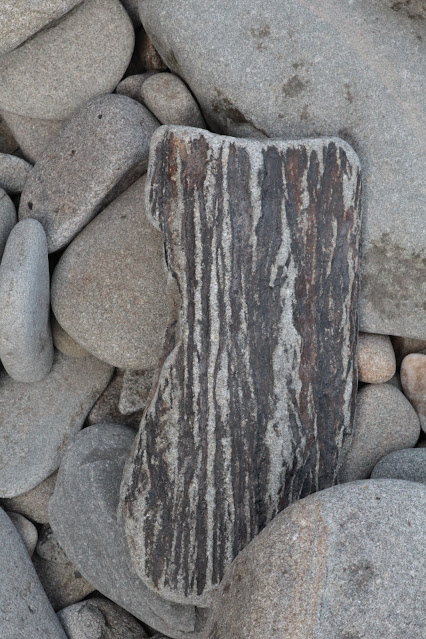Last weekend we made a little day trip to visit Cape Enrage. It's a beautiful spot on the New Brunswick coastline with lovely views and a very rocky beach. The beach rocks are interesting because there are many that have fossil evidence on them.
There is a lighthouse at Cape Enrage, although it is not a manned lighthouse. For many years it was manned, and there is a list of all the lightkeepers on display. The views from the lighthouse are so beautiful. On a clear day, you can easily see across to Nova Scotia.

There is an active fog horn there, and if you go on a foggy day, you'll get an earful! There's even a warning sign because the foghorn is so loud that it can cause hearing damage. Fortunately, it was a sunny day for our visit.
There is a narrow set of metal stairs that go down to the rocky beach.
If you like, instead of the stairs, you can use the rappelling station to rappel down the rocks to the beach. I did not take that route!
The rocks are largely bare, although as you get closer to the water, some of them are covered in seaweed, the most common type of which is this bladderwrack, which is a bit slippery to try to walk on.
Most of the rocks have meandering trails on them, like this.
The trails are caused by periwinkle snails. These are the common periwinkle,
Littorina littorea.
Here are some in a rock pool.
All along the edge of the rocky beach are the tall rocky cliffs. There are regular rockfalls that make the rocks on the beach. Each time new pieces of rock fall, new fossils are revealed. They do recommend not walking right next to the cliffs (at the bottom) because of the potential of falling rocks.

This was an interesting spot in the rock cliffs. You can see that something was once lodged in that space, but it must have fallen out at some point. It was hard to estimate, but that hole is probably about 3 feet wide.
It was a long way off though.
Some of the rock formations are just fascinating. These layers reminded me of puff pastry.
In other places, the layers are very different - quite square and slab-like, rather than curving and organic-looking.
From time to time, I would see remnants of seagulls having eaten their lunch, like this empty European green crab shell.
Here's Marc standing at the base of a cliff face, to give you a sense of scale.
Some places have fossil evidence of wave-like formations.
We found various types of fossils on our beach walk and I took some pictures. It's illegal to take the fossils away, so you just leave them in place and let everybody have a chance to admire them. There are panels at the beginning of the trail to the beach that explain some of the fossil types. We think this is bark of something called Cordaites, which are an extinct division of Progymnosperm trees. They were over 100 feet tall (30 m) and may have been similar to modern mangrove trees.
This is a fossilized giant horsetail. The horsetails we see today are a small roadside and ditch weed. These fossils came from Calamites, which are giant horsetails reaching 30 feet tall (10 m) where they grew along riverbanks. These fossils are casts of the inner pith core of the plant where sediment would accumulate.
Some rocks have a surface like this one. These are called conglomerates, and are often caused by fast moving rivers or flash floods that carried gravel, pebbles, and rocks into a mixture.
More tree bark.
It's fun to try to find rocks with fossil evidence in the jumble, but a bit hard on the ankles walking along this beach.
Here you can see the stairs we came down...and went back up again!
Here's Marc with his standard jolly expression.
I don't think this is a fossil. I think it's a change in rock composition. The rock information panels told me that if ground water running through the sediments was exposed to oxygen, the iron in the water would rust to form iron oxide in the rocks, causing staining.
You can see lots of evidence of sudden rock falls, which encourages one to stay back from the cliff base.
I couldn't help but keep taking pictures of interesting rock formations.
Here you can see periwinkle snails resting on the rock ledges.
Another tree bark fossil.
Some rocks showed evidence of plant debris, such as this one. The diagonal piece across the middle is fossilized evidence of some kind of plant life - perhaps a leaf or a branch.
These dark rectangular patches are quite common as well - also plant fossil evidence - I think stems.
There are still groundwater springs that come out through the cliffs and in some places they cause algae to grow and also cause staining as I described earlier.
Plants, such as this sea plantain, eke a living out of the rocks.
Not sure what this fossil is - might be a plant, or something else!
More giant horsetail.
We stopped by another beach on our way out of the area, and saw this family walking with their...cat!
The cat seemed quite happy hanging out on the shoulders of its owner.
When we were leaving, the tide was coming in. Cape Enrage is on the Bay of Fundy, so it is part of the coastline that sees the highest tides in the world. The waves were growing in intensity, but not huge.
On the way home, we briefly stopped at a marsh dedicated to Lars Larsen, a project made possible by Ducks Unlimited. Lars was an internationally known artist originally from Denmark, but he lived in New Brunswick for many years and was a very dedicated conservationist. The marsh was beautifully peaceful, and I took a picture of a lovely bluet.
It's hard to get one to sit still for long. I think it's a marsh bluet, but I'm not sure.
All in all, it was a very interesting day trip.








































































